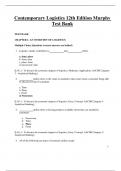Exam (elaborations)
Complete Test Bank Contemporary Logistics 12th Edition Murphy Questions & Answers with rationales (Chapter 1-14)
- Course
- Institution
- Book
Contemporary Logistics 12th Edition Murphy Test Bank Complete Test Bank Contemporary Logistics 12th Edition Murphy Questions & Answers with rationales (Chapter 1-14) PDF File All Pages All Chapters Grade A+
[Show more]



